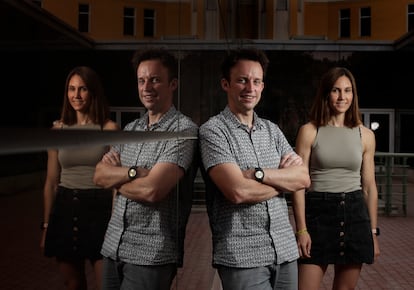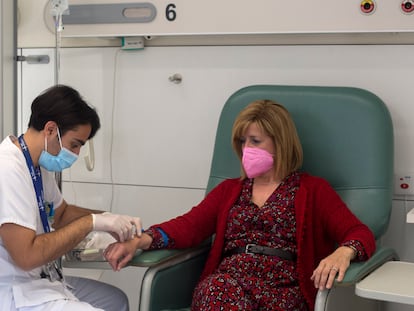Major study of genomic aberrations in cancers will guide treatment of the most lethal tumors
Scientists from Spain and the UK have produced the first major classification of the mechanisms that help tumors grow, elude the immune system and resist drugs

A cancer cell is an aberration as anomalous as a version of the Miguel Cervantes classic, Don Quixote of La Mancha, with the opening line written backwards (“…eman esohw ecalp a ni, ahcnaM aL ni erehwemoS”); seven knights-errant instead of one; a character with nine heads; where the journey to Barcelona was made in reverse; and millions of pages of descriptions of the protagonist endlessly charging windmills. Such an unthinkable perversion of the original is entirely possible inside a cancer cell.
Scientists have known for decades that cancer not only causes mutations or misprints of a single letter in our genome – for example, an A for a C in a book with three billion of these perfectly arranged letters – but it also causes major distortions in genome organization.
Using the analogy of a book, the human genome has 23 chapters, but cancerous tumors can multiply and erase chapters, spell entire chapters backwards, or freely repeat some passages. These transformations provide the molecular machinery for tumors to grow much faster than healthy tissues, elude immune system responses, and resist some cancer therapies. These lesions, called genomic instability, are present in almost all tumor types and in 100% of metastases, which cause 90% of all cancer deaths. The ability to understand and eliminate this genomic madness will provide the tools to stop the progression of most lethal tumors.
On June 15, the most comprehensive study to date of the causes of these genomic aberrations in cancer was published. Nearly 7,000 tumors classified in 33 different types were studied. The study identified 17 large-scale patterns of genomic damage that have important implications for the diagnosis and treatment of the sickest patients. Another study analyzed more than 9,000 tumors and found 21 similar aberrations. Both studies were published in the prestigious science journal Nature.
“We are starting to see some logic in all the madness,” said Geoff Macintyre, an Australian computational biologist at the Spanish National Cancer Research Centre (CNIO) in Madrid, and co-author of one of the studies. “Cancers that are harder to survive, such as tumors in the ovaries, pancreas, esophagus, lung and brain gliomas, all have a high degree of genomic instability. Until now, we have not been able to understand the consequences of this genomic chaos because it’s different in each patient. In this study, we didn’t analyze the consequences, but the causes,” said Macintyre.
The 17 patterns identified are universal, regardless of where the tumor is located. The first pattern is an unequal distribution of chromosomes among the cancer cells, which causes some cells to lose chromosomes while others carry them twice. To use the Don Quixote analogy again, the second pattern causes repetitions and consecutive amputations, such as, “Somewhere in La Mancha, somewhere in La Mancha, an ancient shield, a skinny nag and a greyhound for racing, an ancient shield, a skinny nag and a greyhound for racing.”
CNIO researcher Bárbara Hernando realized that these confused patterns reveal molecules and mechanisms that are absent in healthy cells and that can be treated with drugs available today. Hernando, a molecular biologist from Castellón (Spain) and gold-medal winning pentathlete, has compiled 44 examples of therapies targeting genetic errors in cancer that are already approved for a specific type of tumor, and that could also be used against other difficult-to-treat tumors that exhibit one or more patterns of instability.
The authors of the study, which was conducted in conjunction with the UK’s National Cancer Institute, also found that the patterns predict how tumors will evolve and whether they will be vulnerable to platinum compounds, a type of chemotherapy. “These biomarkers may allow the universal application of cancer therapies,” said Hernando.
Abel Gonzalez, a scientist with the Barcelona Institute for Biomedical Research, is coordinating a $10.6 million European project to classify all the small-scale genetic changes – one-letter deletions – in each tumor, in hopes of improving their treatment. “This new study goes a step further because it provides biomarkers on a large genomic scale that can be used to apply a more general approach to cancer diagnosis and treatment,” he said.
The ideal would be the ability to administer the same drug to treat many different tumor types. There are already some examples of this treatment, such as immunotherapies for patients with particular mutations, regardless of tumor location. Another example are the PARP inhibitors used to target one specific mutation in ovarian cancer, but that are now being tested in other kinds of tumors with the same defect.
“Many times we look for cancer-causing mutations and don’t find them,” said Andrés Aguilera, a past winner of Spain’s National Genetics Award. “These new genomic instability profiles enable us to identify tumors that are susceptible to drugs specifically designed for patients in whom these mutations are known. But a successful treatment will probably depend a lot on the individual tumor,” he said.
In 2020, the most comprehensive genomic study of cancer to date enabled the detection of tumors before they appear by locating dangerous causal mutations. Macintyre, also one of the authors of that study, said: “If we really want to cure cancers with high genomic instability, we have to intervene before they occur.”
Like pancreatic cancer, ovarian cancer is a severe challenge because the disease has few observable symptoms, and the first mutations occur 20 years before diagnosis. Macintyre’s next objective is to try to get ahead of lung cancer by analyzing a few cells extracted during a diagnostic test like a bronchoscopy that could signal a causal mutation. But what can be done if the patient does not yet have cancer? “We don’t know,” admitted Macintyre, who started a new company to work on his findings. Perhaps this is the beginning of a new way to administer chemotherapy in much smaller and more targeted doses. The remaining challenges are enormous, but Macintyre’s hope is that “every time we look at the genomic instability of a tumor, things will start to make sense.”
Tu suscripción se está usando en otro dispositivo
¿Quieres añadir otro usuario a tu suscripción?
Si continúas leyendo en este dispositivo, no se podrá leer en el otro.
FlechaTu suscripción se está usando en otro dispositivo y solo puedes acceder a EL PAÍS desde un dispositivo a la vez.
Si quieres compartir tu cuenta, cambia tu suscripción a la modalidad Premium, así podrás añadir otro usuario. Cada uno accederá con su propia cuenta de email, lo que os permitirá personalizar vuestra experiencia en EL PAÍS.
¿Tienes una suscripción de empresa? Accede aquí para contratar más cuentas.
En el caso de no saber quién está usando tu cuenta, te recomendamos cambiar tu contraseña aquí.
Si decides continuar compartiendo tu cuenta, este mensaje se mostrará en tu dispositivo y en el de la otra persona que está usando tu cuenta de forma indefinida, afectando a tu experiencia de lectura. Puedes consultar aquí los términos y condiciones de la suscripción digital.
More information
Últimas noticias
The impact of Ecuador’s mega-prison: A polluted river, cleared forests and military checkpoints
Corinne Low: ‘I’m more concerned about the female happiness gap than the gender wage gap’
Trump traveled on Epstein’s plane ‘many more times’ than previously thought, according to new documents
Venezuelan exiles in Madrid scramble to salvage Christmas plans after flight cancellations
Most viewed
- The low-cost creative revolution: How technology is making art accessible to everyone
- Christian Louboutin: ‘Young people don’t want to be like their parents. And if their parents wear sneakers, they’re going to look for something else’
- All the effects of gentrification in one corner of Mexico’s Colonia Roma
- Liset Menéndez de la Prida, neuroscientist: ‘It’s not normal to constantly seek pleasure; it’s important to be bored, to be calm’
- Christmas loses its festive spirit: ICE fears cast shadow over religious celebrations











































